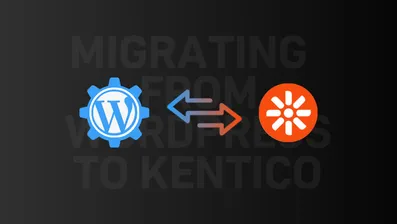Thinking about moving your Magento store to Kentico?
If you’re managing both content and e-commerce on separate platforms, you’ve probably faced inefficiencies that slow your business down. That’s where Kentico steps in, offering a unified solution to simplify your operations.
Migrating may feel like a big step, but it’s the key to unlocking a seamless digital experience for your customers. With Kentico, you get the perfect balance of robust content management and powerful e-commerce features, all in one place.
Let’s walk through why migrating to Kentico can transform how you manage your online store, and how to make the process smooth and hassle-free.
Why Migrate from Magento to Kentico?
You might be asking, “Why make the switch?”
Let’s face it, Magento is a strong e-commerce platform, but when it comes to blending content and commerce, it falls short.
Kentico steps up by providing a unified system where you can manage everything from product listings to dynamic content without switching tools.
In other words, you can truly master eCommerce with Kentico:
1. Struggling with Content Management?
Magento is built for e-commerce, not for creating engaging content like blogs or personalized pages.
If your customers crave a blend of storytelling and shopping, Kentico gives you the tools to deliver both.
2. Need More Marketing Flexibility?
Kentico comes equipped with marketing automation, personalization, and analytics features that Magento simply doesn’t match.
Want to send personalized offers based on a customer’s browsing history?
Kentico makes it easy.
3. Scaling Your Business?
If growth is on your radar, Kentico’s scalability is a game-changer (but don’t worry, we won’t call it that).
Whether you’re expanding your product catalog or reaching new markets, Kentico grows with you.
Benefits of Kentico for E-Commerce Businesses
Switching to Kentico isn’t just about solving problems, it’s about unlocking opportunities.
With Kentico, your e-commerce platform becomes a hub for innovation and efficiency. Let’s explore what it brings to the table i.e. benefits of kentico:
► Unified Content and Commerce
Tired of juggling multiple systems?
Kentico combines content management and e-commerce under one roof.
This means no more switching between platforms, making your workflow smoother and your team happier.
► Advanced Marketing Tools
Want to nurture customer relationships with precision?
Kentico’s built-in marketing automation and personalization features help you tailor content and promotions for each customer.
It’s like speaking directly to their needs, every time.
► Scalable Architecture
Kentico is built to grow with you.
Whether you’re adding new products, expanding to global markets, or handling a surge in traffic, Kentico scales effortlessly to meet your demands.
► Multichannel Support
From mobile apps to social media integrations, Kentico ensures your store reaches customers wherever they are.
It’s a true “anytime, anywhere” solution for modern businesses.
► Built-In Analytics
Make smarter decisions with real-time insights.
Kentico’s analytics tools let you track customer behavior, optimize campaigns, and measure ROI, all without third-party plugins.
Preparing for Magento to Kentico Migration
Thinking about migration can feel overwhelming, but don’t worry, it’s all about proper planning.
Taking the right steps beforehand ensures a smooth transition, saving you time and resources in the long run. Here’s how to get started.
♦ Analyze Your Current Setup
Start by reviewing your Magento store.
What data needs to move?
This includes products, customer information, order history, and any custom features. Identifying these elements upfront will help you plan efficiently.
♦ Back Up Everything
Before making any changes, back up your Magento store.
This creates a safety net in case something goes wrong during migration. Think of it as your “just in case” insurance.
♦ Clean Up Your Data
Not all data needs to come along for the ride. Outdated products, inactive users, and old orders?
It’s the perfect time to leave them behind. Streamlining your data makes the migration process faster and cleaner.
♦ Choose the Right Tools and Team
Migration involves both technical expertise and the right tools.
Partnering with a team experienced in Kentico migration ensures that no detail gets overlooked.
♦ Set Clear Goals
What do you want to achieve with Kentico? Better content management? Advanced marketing capabilities?
Clear goals guide the migration process and help you measure success post-migration.
Steps to Migrate Magento Store to Kentico
Ready to roll up your sleeves?
Migrating from Magento to Kentico is a multi-step process, but with a clear plan, you can make it seamless. Here’s how to tackle it:
Step 1: Export Data from Magento
Start by exporting your store’s data, including products, categories, customer profiles, and order histories.
Magento provides tools to help with this, but double-check for completeness to avoid missing anything important.
Step 2: Set Up Kentico
Before importing your data, set up a fresh Kentico environment.
Configure the CMS to match your business needs, such as creating categories, setting up content templates, and enabling e-commerce modules.
Step 3: Migrate Products and Categories
This is where your products, images, and categories find their new home.
Use Kentico’s import tools or a custom script to ensure everything moves correctly.
Review after the transfer to fix any discrepancies.
Step 4:Migrate Customer and Order Data
Your customers’ data, including profiles and purchase history, is crucial.
Transferring this securely is essential to maintaining trust and ensuring a smooth experience for returning customers.
Step 5: Transfer Content
Blogs, landing pages, and other content need to be manually recreated or imported into Kentico.
This is a great opportunity to refresh outdated content and improve its structure.
Step 6: Integrate Third-Party Tools
Do you rely on third-party services for payments, shipping, or marketing?
Ensure these integrations are compatible with Kentico and set them up accordingly.
Step 7: Perform Testing
Before going live, thoroughly test your new Kentico store.
Check for broken links, missing images, and functionality issues. Better safe than sorry!
Step 8: Launch and Monitor
Once everything checks out, it’s time to launch.
Monitor performance in the initial days to catch any issues quickly and fine-tune as needed.
Challenges in Magento to Kentico Migration (and How to Overcome Them)
No migration comes without a few hiccups along the way.
But knowing what to expect can help you tackle these challenges head-on.
Let’s walk through the common obstacles and how to address them.
1] Data Compatibility Issues
Not all data structures in Magento align perfectly with Kentico. This can lead to missing fields or errors during migration.
How to Solve:
Use data mapping tools or work with a migration expert who understands both platforms. This ensures everything from product details to customer data aligns properly.
2] Downtime Concerns
Worried about your store being offline during migration? Extended downtime can hurt your sales and customer trust.
How to Solve:
Plan for migration during low-traffic periods and conduct tests in a staging environment. A phased migration can also minimize disruptions.
3] Loss of SEO Rankings
Migrating your store can impact your existing SEO efforts if URLs or metadata aren’t transferred correctly.
How to Solve:
Set up 301 redirects for old URLs and verify that metadata, alt tags, and site structure remain intact. Kentico’s SEO-friendly tools can help maintain your rankings.
4] Integration Failures
Third-party services like payment gateways and CRMs may not work seamlessly after migration.
How to Solve:
List all integrations beforehand and check their compatibility with Kentico. Update APIs and test each integration thoroughly.
5] Unfamiliarity with Kentico
Moving to a new platform means your team may face a learning curve.
How to Solve:
Schedule training sessions and provide user guides to help your team get comfortable with Kentico’s interface and features.
6] Budget Overruns
Unexpected issues during migration can lead to additional costs.
How to Solve:
Outline a detailed migration plan and budget for contingencies. Working with a professional team can help avoid surprises.
Standout Features of Kentico for E-Commerce
Migrating to Kentico isn’t just about leaving Magento behind, it’s about upgrading to a platform that makes managing your e-commerce and content a breeze.
Let’s explore what sets Kentico apart.
○ Unified Content and Commerce
Imagine managing your products and creating stunning content all in one place.
Kentico’s unified platform eliminates the need for juggling multiple systems, saving you time and headaches.
○ Headless CMS Capabilities
Want to deliver content across multiple channels, websites, mobile apps, even smart devices?
Kentico’s headless CMS makes it easy to provide a consistent experience everywhere.
○ Personalized Shopping Experiences
Kentico’s personalization tools let you tailor product recommendations, promotions, and content based on individual customer behavior.
It’s like giving every shopper a personal assistant.
○ Marketing Automation
From email campaigns to abandoned cart reminders, Kentico helps you stay connected with customers at the right time without lifting a finger.
Kentico and marketing go hand in hand.
○ Multilingual and Multistore Support
Planning to expand internationally?
Kentico supports multiple languages and stores, allowing you to cater to a global audience effortlessly.
○ Robust Analytics and Reporting
Knowledge is power, and Kentico delivers it.
Track customer behavior, measure campaign performance, and fine-tune your strategy with built-in analytics.
○ Scalable Architecture
Whether you're a small business or a growing enterprise, Kentico scales with your needs, ensuring smooth performance during peak times.
○ Easy Integration with Third-Party Tools
From payment gateways to shipping solutions, Kentico plays well with others, ensuring your favorite tools integrate seamlessly.
Cost of Magento to Kentico Migration
How much will it cost to migrate your Magento store to Kentico?
The total depends on your specific needs, but let’s break it down with a clear range and cost structure.
Component | Estimated Cost Range |
Data Migration (Products, Customers, Orders) | $2,000–$8,000 |
Custom Features Rebuild | $3,000–$10,000 |
Third-Party Integrations | $1,000–$5,000 |
Redesign or Design Adaptation | $2,000–$10,000 |
Testing and Quality Assurance | $1,000–$3,000 |
Typical Cost Range
For most businesses:
- Small to Medium-Sized Stores: $10,000–$25,000
- Large Stores with Complex Features: $30,000–$50,000 or more
Why Invest in Migration?
While migration costs may seem significant, the benefits of a unified platform like Kentico, enhanced efficiency, better customer experiences, and scalability, make it a smart long-term investment.
Your Partner for Magento to Kentico Migration
Looking for a hassle-free Magento to Kentico migration? DotStark has you covered.
As a leading kentico development company, we specialize in seamless migrations that preserve your data integrity while optimizing your new Kentico platform for success. From transferring your product catalog and customer data to integrating essential tools and features, we ensure every detail is handled with precision.
Our experienced team works closely with you to understand your unique business needs, delivering a solution tailored to your goals. Whether you’re a small business or an enterprise, we’ll help you unlock the full potential of Kentico’s advanced features.
Ready to get started? Contact DotStark today and partner with a trusted Kentico development company that puts your business first.
Conclusion
Migrating from Magento to Kentico is more than just a technical upgrade, it’s a strategic move to streamline your operations and enhance your customer experience.
Kentico’s unified platform offers the perfect blend of content management and e-commerce tools, making it easier to scale, personalize, and grow your business. Yes, migration comes with its challenges, but with careful planning and the right team by your side, the benefits far outweigh the effort.
If you’re ready to transform your online store, Kentico is the solution you’ve been looking for. Why wait? Start your migration journey today and unlock the potential of a fully integrated platform.
Frequently Asked Questions
Magento to Kentico migration involves transferring your e-commerce store and content management system from Magento to Kentico. It includes moving product data, customer information, and content while ensuring everything functions smoothly on Kentico’s platform.
The duration depends on the complexity of your store and the amount of data being transferred. A typical migration can take anywhere from a few weeks to a few months. Planning and testing phases are crucial for a smooth transition.
With proper planning, SEO rankings should remain intact. By setting up 301 redirects for old URLs and maintaining your metadata, you can ensure that your search rankings are preserved.
Kentico offers a unified platform for both content management and e-commerce, robust marketing automation tools, advanced analytics, scalability, and easier integrations. It simplifies your workflow and enhances your ability to personalize and engage customers.
Absolutely! DotStark specializes in Magento to Kentico migration, providing end-to-end support from data migration to integration and design. Our experienced team ensures a seamless transition with minimal disruption to your business operations.







 +91 9680599916
+91 9680599916
 vanshika@dotstark.com
vanshika@dotstark.com
